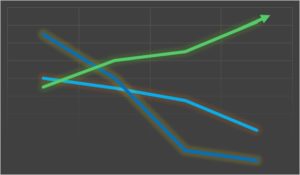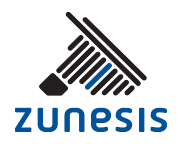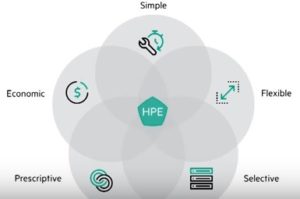Using Data to Determine the Best Way to Store Your Data
Numbers can be made to say many things. To quote one of the most innovative thinkers of our time: “Aw, you can come up with statistics to prove anything. Forty percent of all people know that.” – Homer Simpson
True, numbers can be spun in numerous ways, but data can’t be denied. Along those lines, decisions in IT revolve around very expensive purchases – and buyers need facts to support every purchase.
So, here are some facts:
 In storage, what we see is a market slowly slipping, with all the stalwarts declining faster than the overall market (2.3% in 2015)… all except one: Hewlett Packard Enterprise. 2015 Revenue was down for EMC by 5.9% and NetApp 14.3% (ouch!). Dell Revenue was down 5.6% last fiscal year as well. IBM is now an anecdote.
In storage, what we see is a market slowly slipping, with all the stalwarts declining faster than the overall market (2.3% in 2015)… all except one: Hewlett Packard Enterprise. 2015 Revenue was down for EMC by 5.9% and NetApp 14.3% (ouch!). Dell Revenue was down 5.6% last fiscal year as well. IBM is now an anecdote.
Smaller players are not to be overlooked. Pure is on fire with Q4 showing a 152% gain in revenue, but those numbers come at an awful price. 2015 saw a $213.7 million loss actually up from $183.2 million loss in 2014.
HPE has a really good story right now. Split into two companies, the infrastructure enterprise is slimmer, more nimble (pun intended) and it’s the only major storage player growing. HPE is up 7.9% in Q4. That alone is pretty good; but in a segment down 2.2% in the same period, that’s even more impressive.
DCIG rated 3Par as the best Enterprise midrange array. On March 8, 2016, the Storage Performance Council (SPC) released a new SPC-1 result for the 3PAR StoreServ 8450 All-Flash Array, where it achieved a world-leading result of $0.23 SPC-1 $/IOPS™ – making it THE most affordable external all flash array on the planet.
3Par is the only array in Gartner’s magic quadrant for solid state and general purpose – and those are both managed from the same interface.
To put this all into context, if you’re a decision maker looking to make a large investment that’s going to last for the next several years, doesn’t it seem wise to at least look at the only major storage provider that’s healthy, growing, and that also happens to be racking up major accolades?
The business of IT, that is.
Data Protection, Fault-tolerance, Disaster Recovery, and Business Continuity are issues all IT Professionals deal with on some level throughout their career. As important as all four of these are to a business, until recently, only the first two have really been given any attention.
In fact, Data Protection and Fault-tolerance are considered to be fundamental components of any professionally run IT environment. The basic level of Data Protection is, of course, defined by file backup and recovery solutions. When we talk with our clients about Data Protection, these discussions typically start with questions about the software used and the type of media employed to store the backups. For Fault-tolerance, the conversation revolves around discussions of redundancy in your hardware, clustering, and RAID levels.
 In contrast to Data Protection and Fault-tolerance, Disaster Recovery and Business Continuity have, for years, been part of the annual budgeting discussion but usually end up in the “nice to have” pile and are set aside until the next budget cycle. The cost and complexity of these solutions ended up being too expensive and require too many resources to implement. However, within the past 3 to 5 years, we have seen many of our clients elevate the Disaster Recovery and Business Continuity conversations from the “nice to have” to a “must implement” discussion.
In contrast to Data Protection and Fault-tolerance, Disaster Recovery and Business Continuity have, for years, been part of the annual budgeting discussion but usually end up in the “nice to have” pile and are set aside until the next budget cycle. The cost and complexity of these solutions ended up being too expensive and require too many resources to implement. However, within the past 3 to 5 years, we have seen many of our clients elevate the Disaster Recovery and Business Continuity conversations from the “nice to have” to a “must implement” discussion.
There are many factors contributing to the change, but I would contend the two biggest reasons are:
- The extreme dependence most businesses have on the digital world. Reverting to legal pads and cigar boxes simply aren’t options for many businesses today.
- The technology has made implementation of Disaster Recovery and Business Continuity easier and more affordable to accomplish than ever before.
With the ubiquity of virtualization today, discussions about all of these issues has changed significantly. Where once we drew well defined lines between the solutions for Data Protection, Fault-tolerance, Disaster Recovery, and Business Continuity, we are now starting to see those lines blur. To be clear, each of these issues still addresses distinctly different solution requirements. However, technology is allowing us to combine some of these requirements under one toolset.
Even though one solution may cover multiple requirements defined by Data Protection, Fault-tolerance, Disaster Recovery, and Business Continuity, it’s important to go into discussions of these issues understanding the major differences between them.
- Data Protection – These solutions are focused on protecting files and databases from corruption or deletion. In either event, Data Protection solutions should be able to restore a file or database from a point in time. While the file or database may not contain the most recent updates, it is still better than not having it at all.
- Fault-tolerance – As the name implies, these solutions allow part of the hardware or software to fail without losing the entire device or application. For hardware this is accomplished through redundant power supplies and fans. It also includes the implementation of RAID on the disks or clustering for operating systems or hypervisors. Fault-tolerance is usually a protection against a local failure.
- Disaster Recovery – Again, as the name implies, these solutions provide the ability to recover from a disaster. In general, these solutions replicate data and applications to another location or Disaster Recovery Site. The Disaster Recovery Site will typically have compute, network and storage resources to be able to bring part or all of a production environment online in a predetermined period of time; usually defined by hours. The key here is what that period of time will be and to what point in time the data will be recovered. These are more commonly referred to as the RTO and RPO.
- Business Continuity – While Disaster Recovery is designed to bring a business back on line in hours or a few days, Business Continuity is designed to keep a business running in the event of a disaster or, at the very least, have the business running again in minutes and with the most up-to-date data sets.
 As I mentioned earlier in this post, technology today has made implementation of solutions to these four issues far easier than it used to be. However, defining the requirements and navigating through the many solution options can still be a daunting task. At Zunesis we have Solution Architects, with decades of experience, who are ready to help our clients design solutions to protect their Business. With all the options available today it is important to have a partner with the expertise to design, acquire, and implement these essential solutions.
As I mentioned earlier in this post, technology today has made implementation of solutions to these four issues far easier than it used to be. However, defining the requirements and navigating through the many solution options can still be a daunting task. At Zunesis we have Solution Architects, with decades of experience, who are ready to help our clients design solutions to protect their Business. With all the options available today it is important to have a partner with the expertise to design, acquire, and implement these essential solutions.
In addition to experienced Solution Architects, Zunesis partners with some of the most respected names in the industry to provide the hardware and software needed to implement a Business Protection plan. Our partners include Hewlett Packard Enterprise, VMware, VEEAM, Commvault, Zerto, Dakota Cloud Recovery, and others. Click here for a full list of partners.
In future blog posts we may delve into some of the discovery process and solutions more deeply. Until then, you can be sure that, with our experience and our strong partnerships, Zunesis can help achieve your objective of protecting the business today.
Zunesis is recognized in the CRN’s industry standard for the most successful solution provider companies, the Solution Provider 500.
Denver, CO (PRWEB) June 06, 2016
 Zunesis, a Denver-based IT solution provider, announced today that CRN®, a brand of The Channel Company, has named Zunesis to its 2016 Solution Provider 500 list for the sixth time. The SP500 list is CRN’s annual ranking of the largest technology integrators, solution providers, and IT consultants in North America by revenue.
Zunesis, a Denver-based IT solution provider, announced today that CRN®, a brand of The Channel Company, has named Zunesis to its 2016 Solution Provider 500 list for the sixth time. The SP500 list is CRN’s annual ranking of the largest technology integrators, solution providers, and IT consultants in North America by revenue.
The SP500 is CRN’s predominant channel partner award list, serving as the industry standard for recognition of the most successful solution provider companies in the channel since 1995.
Zunesis’ ability to earn this recognition time and time again is a testament to their consistent dedication to their clients. Despite unprecedented change in the IT industry over the last decade, Zunesis has found a way to adapt to the changing marketplace and meet the needs of their clients through each phase of technology’s evolution.
“We’re honored to make this list again,” said Zunesis CEO, Steve Shaffer. “I could not be more proud of the team at Zunesis who is committed to the best interests of our clients. In this constantly-changing IT landscape, our employees always rise to the challenge. No matter what new technologies we need to learn or creative solutions we need to build, my team is always up to the task of providing the absolute best solution to the customer.”
“The 2016 Solution Provider 500 represent a total, combined revenue of over $334 billion—a testament to their success in keeping pace with the rapidly changing demands of today’s IT market,” said Robert Faletra, CEO, The Channel Company. “This prestigious list recognizes those companies with the highest revenue and serves as a valuable industry resource for vendors seeking out top solution providers to partner with. We congratulate each of the Solution Provider 500 companies and look forward to their continued success.”
A sampling from the 2016 Solution Provider 500 list will be featured in the June issue of CRN Magazine and at http://www.CRN.com/sp500.
About Zunesis
Zunesis is a leading IT solution provider with locations in Colorado and Nevada. Our vision centers around an intense focus on serving our customers and bringing value to their business through strategic IT solutions. In 2015, Zunesis was added to the CRN Next-Gen 250 list, recognizing them for their innovation and forward-thinking in the industry. Later, in March 2016, Zunesis was named to the CRN TechElite 250 for the 7th consecutive year as a best-of-breed solution provider with deep technical expertise and premier certifications. For more information, visit the Zunesis Blog or follow us on LinkedIn.
About the Channel Company
The Channel Company enables breakthrough IT channel performance with our dominant media, engaging events, expert consulting and education, and innovative marketing services and platforms. As the channel catalyst, we connect and empower technology suppliers, solution providers and end users. Backed by more than 30 years of unequaled channel experience, we draw from our deep knowledge to envision innovative new solutions for ever-evolving challenges in the technology marketplace. http://www.thechannelco.com
Composable Infrastructure: The Engine for the Idea Economy
In an effort to move toward an Idea Economy, IT must now be able to support two operating environments.
- Traditional Business based off of traditional apps which are Ops driven and cost focused
- Idea Economy which encompasses cloud apps which are Apps driven and agility focused
A new category of infrastructure is needed to power the Idea Economy. In the traditional model, Application and Operations optimization took months to deliver. Converged Infrastructure took days, Hyper-converged took minutes, and now Composable takes seconds.
 Composable Infrastructure, also known as HPE’s new Synergy, simplifies Infrastructure as a Service by providing the following:
Composable Infrastructure, also known as HPE’s new Synergy, simplifies Infrastructure as a Service by providing the following:
- Hardware and software architecture as one
- Fluid IT
- Software-defined everything
- Unlimited scale
- Physical, virtual, and containerized workloads
Composable Infrastructure is the new engine for the Idea Economy allowing customers to take leaps and bounds:
- REDUCE over-provisioning and CAPEX. Users can precisely compose any compute with any storage pool.
- DEPLOY at cloud-like speed. Power up to a portal in minutes.
- DEVELOP more apps, faster. Program Infrastructure the way you want.
- UPDATE firmware seamlessly. Frictionless operations reduce operational effort.
HPE’s Composable Infrastructure multi-year vision empowers IT to create and deliver new value instantly and continuously for traditional business and the Idea Economy.
- Run Anything – Optimize all apps and service-levels.
- Move Faster – Accelerate app and service delivery.
- Work Efficiently – Reduce operational effort and cost.
- Unlock Value – Increase productivity and control.
The path to Composable Infrastructure allows an ease of management and interoperability across the entire infrastructure. Converged Blocks with Composable attributes provide value to your existing infrastructure. With HPE’s fully Composable Infrastructure, you receive continuity and investment protection of tools, integration, and process. HPE’s Composable Infrastructure transforms cost to value creation with infrastructure that bridges traditional and new.




